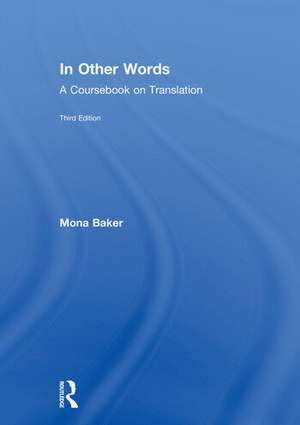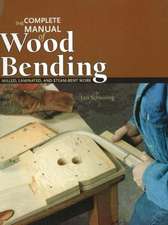In Other Words: A Coursebook on Translation
Autor Mona Bakeren Limba Engleză Hardback – 9 mar 2018
Drawing on linguistic theory and social semiotics, the third edition of this best-selling text guides trainee translators through the variety of decisions they will have to make throughout their career. Each chapter offers an explanation of key concepts, identifies potential sources of translation difficulties related to those concepts and illustrates various strategies for resolving these difficulties. Authentic examples of translated texts from a wide variety of languages and genres are examined, and practical exercises and further reading are included at the end of each chapter.
The third edition has been fully revised to reflect recent developments in the field and includes a new chapter that engages with the interplay between verbal and visual elements in genres as varied as children’s literature, comics, film, poetry and advertisements.
This key text remains the essential coursebook for any student of translation studies.
| Toate formatele și edițiile | Preț | Express |
|---|---|---|
| Paperback (1) | 299.70 lei 3-5 săpt. | +34.88 lei 4-10 zile |
| Taylor & Francis – 9 mar 2018 | 299.70 lei 3-5 săpt. | +34.88 lei 4-10 zile |
| Hardback (1) | 772.76 lei 6-8 săpt. | |
| Taylor & Francis – 9 mar 2018 | 772.76 lei 6-8 săpt. |
Preț: 772.76 lei
Preț vechi: 1032.44 lei
-25% Nou
Puncte Express: 1159
Preț estimativ în valută:
147.91€ • 160.72$ • 124.33£
147.91€ • 160.72$ • 124.33£
Carte tipărită la comandă
Livrare economică 21 aprilie-05 mai
Preluare comenzi: 021 569.72.76
Specificații
ISBN-13: 9781138666870
ISBN-10: 1138666874
Pagini: 390
Ilustrații: 23
Dimensiuni: 174 x 246 x 27 mm
Greutate: 0.93 kg
Ediția:3
Editura: Taylor & Francis
Colecția Routledge
Locul publicării:Oxford, United Kingdom
ISBN-10: 1138666874
Pagini: 390
Ilustrații: 23
Dimensiuni: 174 x 246 x 27 mm
Greutate: 0.93 kg
Ediția:3
Editura: Taylor & Francis
Colecția Routledge
Locul publicării:Oxford, United Kingdom
Public țintă
Postgraduate, Professional, and UndergraduateCuprins
Contents
List of figures
List of tables
Preface to the second edition
Preface to the first edition
Acknowledgements
Credits
1 Introduction
1.1 About the organization of this book
1.2 Examples, back-translations and the languages of illustration
Suggestions for further reading
Note
2 Equivalence at word level
2.1 The word in different languages
2.2 Lexical meaning
2.3 The problem of non-equivalence
Exercises
Suggestions for further reading
Notes
3 Equivalence above word level
3.1 Collocation
3.2 Idioms and fixed expressions
Exercises
Suggestions for further reading
Notes
4 Grammatical equivalence
4.1 Grammatical versus lexical categories
4.2 The diversity of grammatical categories across languages
4.3 A brief note on word order
4.4 Introducing text
Exercises
Suggestions for further reading
Notes
5 Textual equivalence: thematic and information structures
5.1 A Hallidayan overview of information flow
5.2 The Prague School position on information flow: functional
sentence perspective
Exercises
Suggestions for further reading
Notes 187
6 Textual equivalence: cohesion
6.1 Reference
6.2 Substitution and ellipsis
6.3 Conjunction
6.4 Lexical cohesion
Exercises
Suggestions for further reading
Notes
7 Pragmatic equivalence
7.1 Coherence
7.2 Coherence and processes of interpretation: implicature
7.3 Coherence, implicature and translation strategies
Exercises
Suggestions for further reading
Notes
8 Semiotic equivalence
8.1 Semiotic resources and semiotic regimes
8.2 Creative deployment of semiotic resources
8.3 Translating semiotically complex material
Exercises
Suggestions for further reading
Notes
9 Beyond equivalence: ethics and morality
9.1 Ethics and morality
9.2 Professionalism, codes of ethics and the law
9.3 The ethical implications of linguistic choices
9.4 Concluding remarks
Exercises
Suggestions for further reading
Notes
Glossary
References
Name index
Language index
Subject index
List of figures
List of tables
Preface to the second edition
Preface to the first edition
Acknowledgements
Credits
1 Introduction
1.1 About the organization of this book
1.2 Examples, back-translations and the languages of illustration
Suggestions for further reading
Note
2 Equivalence at word level
2.1 The word in different languages
2.2 Lexical meaning
2.3 The problem of non-equivalence
Exercises
Suggestions for further reading
Notes
3 Equivalence above word level
3.1 Collocation
3.2 Idioms and fixed expressions
Exercises
Suggestions for further reading
Notes
4 Grammatical equivalence
4.1 Grammatical versus lexical categories
4.2 The diversity of grammatical categories across languages
4.3 A brief note on word order
4.4 Introducing text
Exercises
Suggestions for further reading
Notes
5 Textual equivalence: thematic and information structures
5.1 A Hallidayan overview of information flow
5.2 The Prague School position on information flow: functional
sentence perspective
Exercises
Suggestions for further reading
Notes 187
6 Textual equivalence: cohesion
6.1 Reference
6.2 Substitution and ellipsis
6.3 Conjunction
6.4 Lexical cohesion
Exercises
Suggestions for further reading
Notes
7 Pragmatic equivalence
7.1 Coherence
7.2 Coherence and processes of interpretation: implicature
7.3 Coherence, implicature and translation strategies
Exercises
Suggestions for further reading
Notes
8 Semiotic equivalence
8.1 Semiotic resources and semiotic regimes
8.2 Creative deployment of semiotic resources
8.3 Translating semiotically complex material
Exercises
Suggestions for further reading
Notes
9 Beyond equivalence: ethics and morality
9.1 Ethics and morality
9.2 Professionalism, codes of ethics and the law
9.3 The ethical implications of linguistic choices
9.4 Concluding remarks
Exercises
Suggestions for further reading
Notes
Glossary
References
Name index
Language index
Subject index
Notă biografică
Mona Baker is Professor Emerita of Translation Studies at the University of Manchester, UK, and Director of the Shanghai Jiao Tong Baker Centre for Translation and Intercultural Studies, China (www.jiaotongbakercentre.org). She is Founding Vice President of the International Association of Translation and Intercultural Studies (IATIS, 2004–2015).
Recenzii
'This is a must-read for anyone who opts for translation and interpreting studies, regardless of their language combinations. It is informative, interesting and inspirational. The author never fails to bring new insight to the readership with each new edition, and this time it is semiotics.'
Wen Ren, Beijing Foreign Studies University, China
'In Other Words is an invaluable resource for linguistic analysis in translation studies. Mona Baker manages to strike the right balance between step-by-step explanation of increasingly complex categories of analysis, from the lexical to the pragmatic, without sacrificing academic rigour. This combination is rare and makes In Other Words the ideal textbook for degree-level study in translation studies.'
Morven Beaton-Thome, Technical University of Cologne, Germany
Wen Ren, Beijing Foreign Studies University, China
'In Other Words is an invaluable resource for linguistic analysis in translation studies. Mona Baker manages to strike the right balance between step-by-step explanation of increasingly complex categories of analysis, from the lexical to the pragmatic, without sacrificing academic rigour. This combination is rare and makes In Other Words the ideal textbook for degree-level study in translation studies.'
Morven Beaton-Thome, Technical University of Cologne, Germany
Descriere
In Other Words has been the definitive coursebook for students studying translation for nearly three decades. Assuming no knowledge of foreign languages, it offers a practical guide based on extensive research in areas as varied as lexis, grammar, pragmatics, semiotics and ethics. The third edition has been fully revised to reflect recent developments in the field and includes a new chapter that engages with the interplay between verbal and visual elements in genres as varied as children’s literature, comics, film, poetry, and advertisements. Written by Mona Baker, a leading international figure in the field, this key text remains the essential coursebook for any student of translation studies.




















